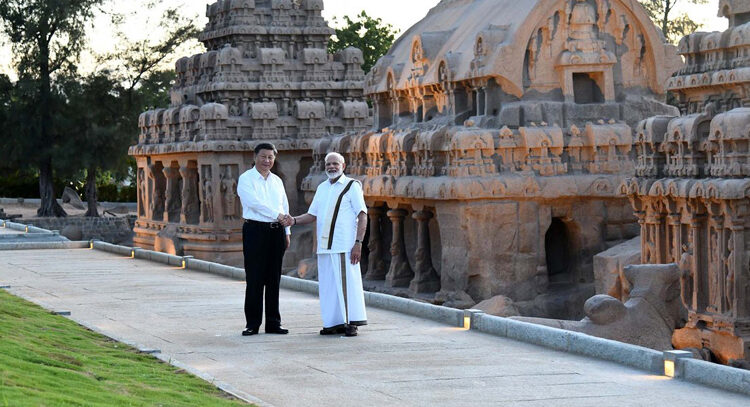
Modi-Xi’s dialogues by the sea: Managing a difficult relationship
All the hypes about Modi-Xi meeting died out soon after the meeting is over. The meeting held in Mammalapuram was all about the place and much anticipated discussion. But did anything substantive come out? SAWM member Nilova Roy Chaudhury tries to find out the answer.
Once upon a time, ‘Dr Kotnis ki amar kahani’ (the immortal story of Dr Kotnis) was the defining narrative of Sino-Indian relations; the good Indian doctor who travelled to the pre-Long March Middle Kingdom and won over the Chinese by treating their sicknesses and even settling there, adopting Chinese characteristics. Then 1962 happened, and hostility and distrust coloured the bilateral relationship, leaving an imprint that survives even six decades later. The Wuhan ‘informal summit’ of April 2018, coming shortly after the Doklam standoff of 2017, was conceived to remove some of that hostility and infuse the relationship between the two neighbours across the Himalayas with an acceptable functionality, by which they could do business together. Friendship is a far cry but a working, moderately comfortable, relationship is the aim, by ensuring “higher levels of strategic communications” between the leaders.
Which is why External Affairs Minister Subrahmanyam Jaishankar’s choice of Mamallapuram, 56 km south of Chennai, as the venue for the second ‘informal summit’ between the Chinese president and Indian prime minister was seen as an inspired choice and immediately accepted by Modi. National Security Adviser Ajit Doval, another trusted aide, was present for some of those ‘informal’ conversations at the world heritage site, and personally oversaw the elaborate security arrangements.
Mahabalipuram, or Mamallapuram in Tamil, is named after the 7th century ‘great warrior’ or ‘Mamallan’ King Narasimhavarman of the Pallava dynasty, during whose flourishing reign maritime trade and cultural linkages were first established between southern India and southeast Asia and beyond to China.
Chinese President Xi Jinping was once governor of Fujian province, where recently discovered sculptures and inscriptions in the Tamil language show the presence of a thriving Indian trading community there over a millennia ago. Among the major exports of that era was Buddhism, which also travelled to China and adopted Chinese characteristics before moving to Korea and elsewhere. Significantly, it was in the later Pallava era, during the reign of King Rajasimhan, that a Chinese ruler of the Tang dynasty sought Indian assistance to keep a resurgent Tibet in check and in gratitude, conferred the Pallava armies with the title of ‘army which cherishes virtue.”
While the Chinese would certainly have done their preparatory homework on the region’s ancient ties with the Middle Kingdom, the architectural magnificence of Mamallapuram’s shore bas-reliefs and sculptures – as was their Premier Chou-en Lai when he visited here back in 1956 – and the grand hospitality, which also impressed Xi, is unlikely to change their policies towards India on issues, they consider fundamental to their strategic interests, including Kashmir and Pakistan.
Beijing had criticised India particularly for its August 5 decision to accord union territory status to Ladakh, which shares a disputed border with China and even raised the issue in Foreign Minister Wang Yi’s address to the UN General Assembly. But the tough rhetoric had given way to language more accommodative of Indian concerns.
Xi’s arrival in Chennai followed a meeting in Beijing between him and Pakistani Prime Minister Imran Khan, whose domestic (and even global) credibility has suffered severely after the Modi government removed the special status the Jammu &?Kashmir constitutionally enjoyed and sought to integrate it into the Indian Union.
Work on the China Pakistan Economic Corridor (CPEC) has also slowed down, reducing Khan’s access to Chinese funds and the imminent threat of the UN Financial Action Task Force (FATF) blacklisting has caught Islamabad in multiple binds. The financial crunch is forcing Khan’s government to unravel, forcing the Pakistan army to step in and even see Army Chief Qamar Javed Bajwa sit in on critical business meetings. Bajwa accompanied Khan to Beijing where the public rhetoric on Kashmir forced New Delhi to object and respond that other countries had no business commenting on India’s “internal affairs”.
Meanwhile, US President Donald Trump publicly calling off the Islamabad-brokered talks between the Taliban and the US last month reduced Pakistan’s indispensability to Washington and increased the threat to it from those Taliban-affiliated groups which were looking to take over Afghanistan. The threat of Pakistan unravelling is a nightmare, not only for India and the region, but also, perhaps more so, for China.
Along with Pakistan, China has tried to ensure that India is kept out of Afghanistan and can play no role there. But Trump’s public cancellation of talks with the Taliban and even more public embrace of Modi and India, particularly at the ‘Howdy, Modi!’ event in Houston, has left Beijing very wary and Islamabad mortified. China’s geopolitical troubles, including US and Western criticism of the situation in Xinjiang and enhanced levels of cooperation between the Quad (US, Japan, Australia and India) in the Indo-Pacific region, are compounded by economic woes from the long and bitter trade standoff with the US.
India, too, has to contend with the Kashmir situation having been internationalised, however much South Block may try to deny the fact, and intense global scrutiny on its moves. The government is also grappling to somehow get the economy into gear and back on track.
When Indian and Chinese leaders meet, Pakistan, perforce, is the elephant in the room. Given the current circumstances, Modi did keep the focus bilateral and impress upon the Chinese that the national interests of both India and China can converge only when they lose some mutual distrust and not encroach upon each other’s core interests; for India, that is an absence of terrorism, including in Kashmir, which will allow it to gain economic stature; for China it is continued economic prosperity that will obviate any domestic unease.
No great breakthroughs or outcomes were expected from the Mamallapuram summit, where the focus was on optics and observers found “a good chemistry” between Modi and Xi, and nothing substantive emerged. With Modi and Xi spending the better part of their time together seeing the sites and discussing cultural convergences along the magnificent, ocean-lapped venue, the real challenge will now be to ensure that the many divergences are better managed and the bilateral economic stakes are raised sufficiently to act as suitable buffer against any future shocks.
After spending five hours of “quality time” together on Day 1, mostly in one-on-one conversation and walks along the monument-studded sea shore and a couple of hours more together on October 12, Modi and Xi decided that “informal summits” were the way forward to manage the fraught bilateral relationship. They found this mechanism a suitable way to “deepen dialogue and to promote mutual understanding…in line with the ‘Wuhan Spirit’ and the ‘Chennai Connect,” a MEA press release issued after the meeting said.
Modi, who accepted an invitation to visit China for the third such informal summit next year said, since Wuhan, “our relations saw increased stability and fresh momentum. We had decided that we would prudently manage our differences and not let them become disputes, be sensitive to each other’s concerns.”
Modi and Xi talked of terrorism and the challenges they face from radicalisation and of trade, agreeing to set up a high-level economic and trade dialogue mechanism to go into trade, investment and services, which would include Finance Minister Nirmala Sitharaman and China’s Vice-Premier Hu Chunhua.
It was interesting to see the release saying that “the leaders recognized that India and China have a common interest in preserving and advancing a rules-based and inclusive international order, including through reforms that reflect the new realities of the 21st Century.” Part of the problem in bilateral ties has been China’s refusal to abide by international rules.
Kashmir did not figure in their talks, Foreign Secretary Vijay Gokhale said, but the boundary issue did, though no new initiatives came up.
Modi sought an early resolution of the boundary dispute through substantive meetings between the two Special Representatives, Wang Yi and Doval, both of whom were present in Mamallapuram. The Indian government moved to ease restrictions in Kashmir during Xi’s brief visit, but the boundary issue looks likely to take a while longer to settle.
As the sun set over the Coromandel coast, from where the earliest linkages between India and China began, and the 24 hours of very public informal summitry ended, the core message from the picture-perfect setting was that the two leaders had made efforts to manage their complicated relationship such that the narrative between the two Asian giants remained positive at least.
The article first appeared in www.southasiamonitor.org

